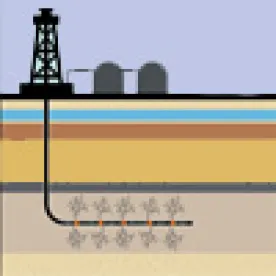Despite the abundance of natural gas within the state and region, and the reputation of natural gas as the cleanest burning of fossil fuels, New York remains a treacherous political environment for companies seeking to expand the use or extraction of gas. The anti-fracking movement maintains a strong base of support in the state and a de facto moratorium on exploration remains in place at the state level. Pipelines, storage fields, compressor station projects, and the highly controversial offshore Port Ambrose liquefied natural gas (LNG) facility continue to meet with public opposition.
Add to the list of obstacles the fact that New York State has yet to establish an effective regulatory regime for in-state liquefied natural gas (LNG) facilities. LNG, produced by cooling natural gas to -260°F, is easier to contain and to move than methane in its gaseous form, making both trucking and shipping much easier. LNG also can be used as a fuel for heavy trucking, providing a cleaner burning alternative to diesel. However, under the Liquefied Natural and Petroleum Gas Act (ECL §§ 23-1701 et seq.), enacted in response to a large LNG facility explosion in Staten Island in 1973, new LNG facilities cannot be constructed in the absence of DEC regulations. Up to now, new LNG regulations have not moved forward due to the stringent, if not unworkable, requirements of the statute. Indeed, New York State is the only state in the country that has not adopted standards for the construction of new LNG storage facilities of any kind within the state.
The New York State Department of Environmental Conservation took the first steps toward allowing the state to take advantage of the numerous environmental and economic benefits of LNG by proposing new rules for the regulation and siting of natural gas facilities last year. After receiving public comments, DEC submitted a revised proposal for the rule, addressing concerns over the safety and size of these facilities. See Revised 6 NYCRR 570 (Proposed). These regulations would cover any storage vessel within the state, with exemptions provided for on-board fuel tanks used to power vehicles and facilities in operation before the passage of Liquefied Natural and Petroleum Gas Act in 1976.
Much of the original and proposed rule remains unchanged. Intrastate transportation of natural gas would still be prohibited unless the route has been authorized, applicants would still have to meet all necessary permitting requirements like demonstrating need and a description of possible environmental impacts, and the NFPA standards are still incorporated into the law by reference. The only substantive change to the proposed rule would be the addition of a 70,000 gallon upper limit on the size of a new facility. Under the originally proposed rules, there was no upper limit on the size of a proposed facility, granting DEC discretion in whether or not to approve a given design. The limit comports with a threshold provided by NFPA 59A, over which the necessary siting offsets change dramatically.
The limit is not surprising, as the principal focus of this regulatory effort was to permit installation of smaller LNG filling stations to service long haul trucking. The concern, whether reasonable or not, over much larger LNG facilities and the overall difficult political terrain for natural gas projects makes the permitting of larger LNG in the state much more unlikely. The revised regulations take these much larger storage facilities off the table and likely will make the proposed regulations less controversial. The revised proposed rule provides a clear limit on the future construction of LNG facilities in state that should not materially impact the development of natural gas filling stations in New York State. According to the 2011 NYSERDA Promulgation Support Study, the upper limit of 70,000 gallon will be consistent with the vast majority of anticipated projects within the first years of the regulatory scheme.
The Notice of Revised Rule was published today in the State Register. As this is a revision to an already proposed rule, no public hearings will be provided. However, DEC is accepting written public comments through December 12, 2014.




 />i
/>i

